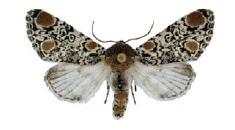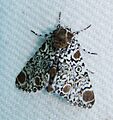Harris's three spot facts for kids
Quick facts for kids Harris's three spot |
|
|---|---|
 |
|
| Scientific classification | |
| Kingdom: | |
| Phylum: | |
| Class: | |
| Order: | |
| Family: | |
| Genus: |
Harrisimemna
|
| Species: |
H. trisignata
|
| Binomial name | |
| Harrisimemna trisignata (Walker, 1856)
|
|
| Synonyms | |
|
|
The Harrisimemna trisignata, also known as Harris's three spot, is a type of moth. It belongs to a large group of moths called the Noctuidae family. A scientist named Francis Walker first officially described this species in 1856. You can find this interesting moth in many parts of North America.
Contents
Where Harris's Three-Spot Moth Lives
This moth lives across a wide area in North America. In Canada, you can find it in Ontario, Quebec, New Brunswick, Nova Scotia, Newfoundland and Labrador, Alberta, and Saskatchewan.
It also lives in many parts of the United States. It has been seen as far south as Arizona. Other states where it has been recorded include Maryland, Pennsylvania, Wisconsin, Georgia, Illinois, Indiana, Iowa, New York, Ohio, Oklahoma, Tennessee, Texas, and Virginia.
What Harris's Three-Spot Moth Looks Like
The Harris's three spot moth is not very big. Its wingspan is usually between 30 and 36 millimeters. This is about 1.2 to 1.4 inches wide.
Life Cycle of the Moth
Adult moths are typically active during the warmer months. In Canada, you can usually see them flying around from May to August. During this time, they will mate and lay eggs.
What Harris's Three-Spot Moth Eats
The young moths, which are called larvae (or caterpillars), eat different kinds of plants. They prefer woody plants, which means plants with hard stems and branches.
Some of their favorite foods include wild raisin, winterberry, and bush honeysuckle. They also enjoy eating the leaves of black willow, white ash, and even apple trees.
Images for kids


